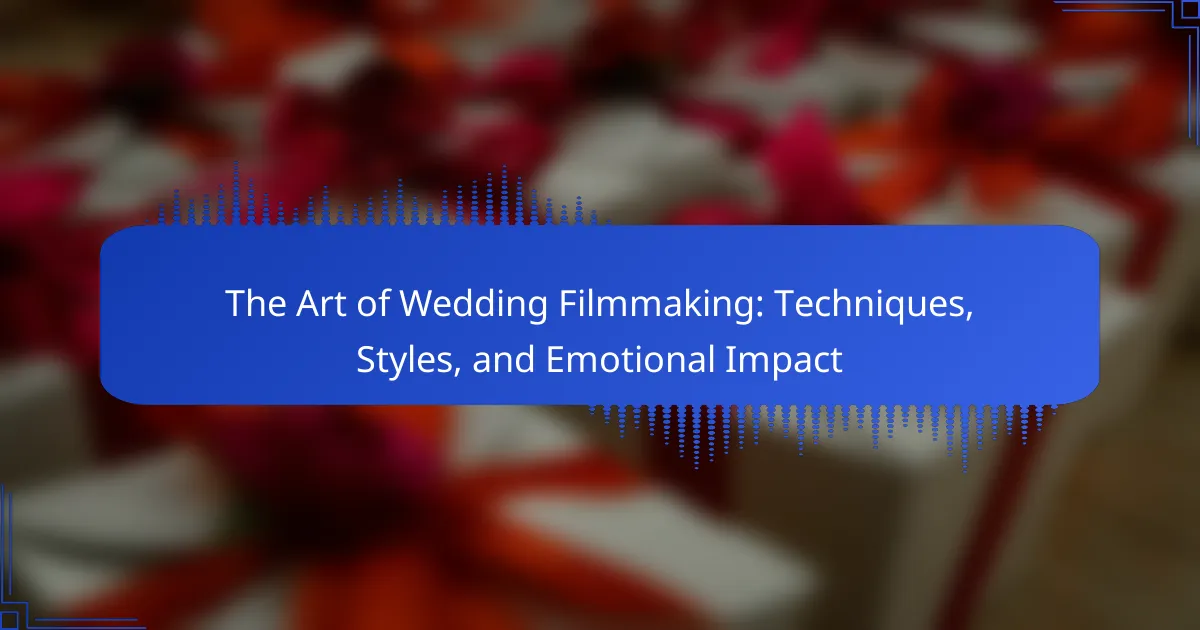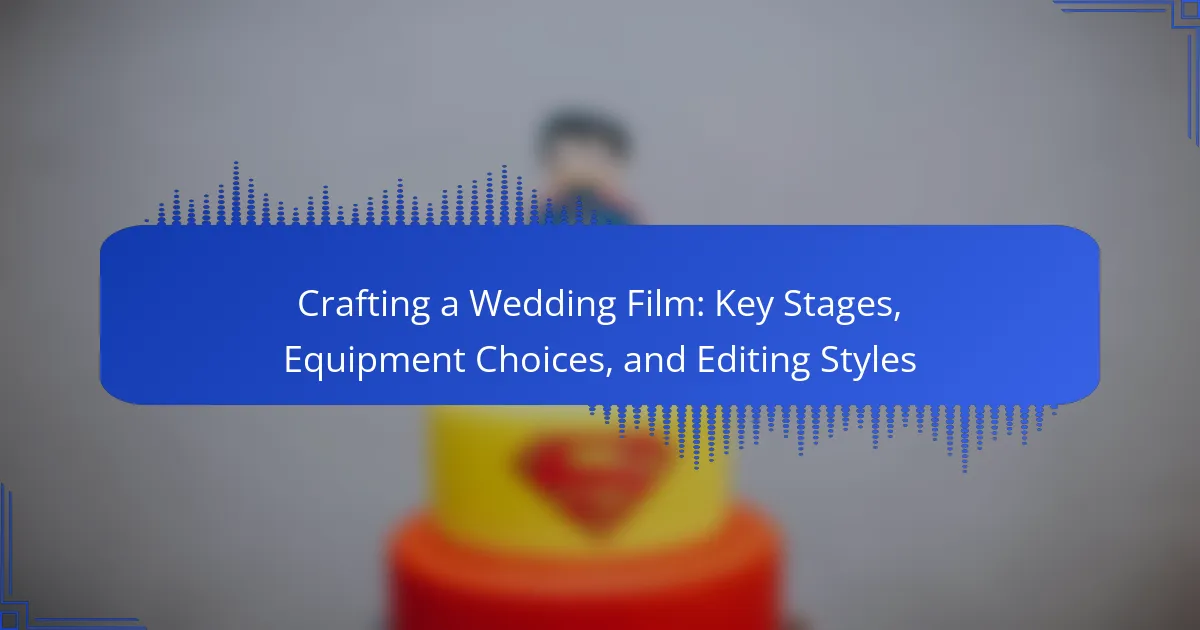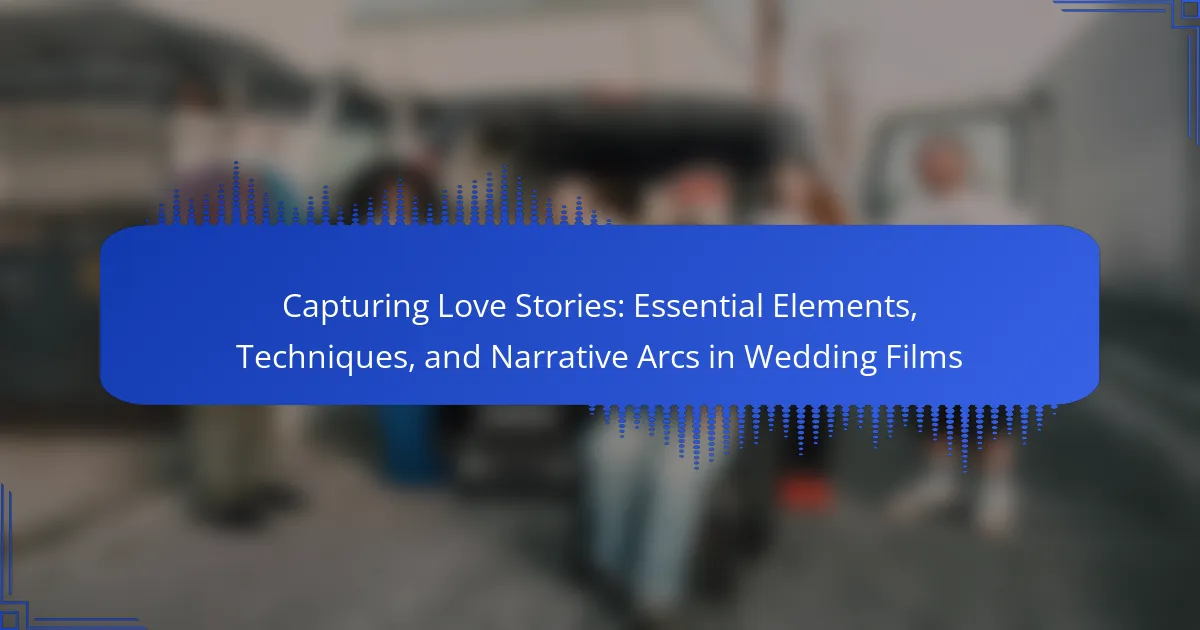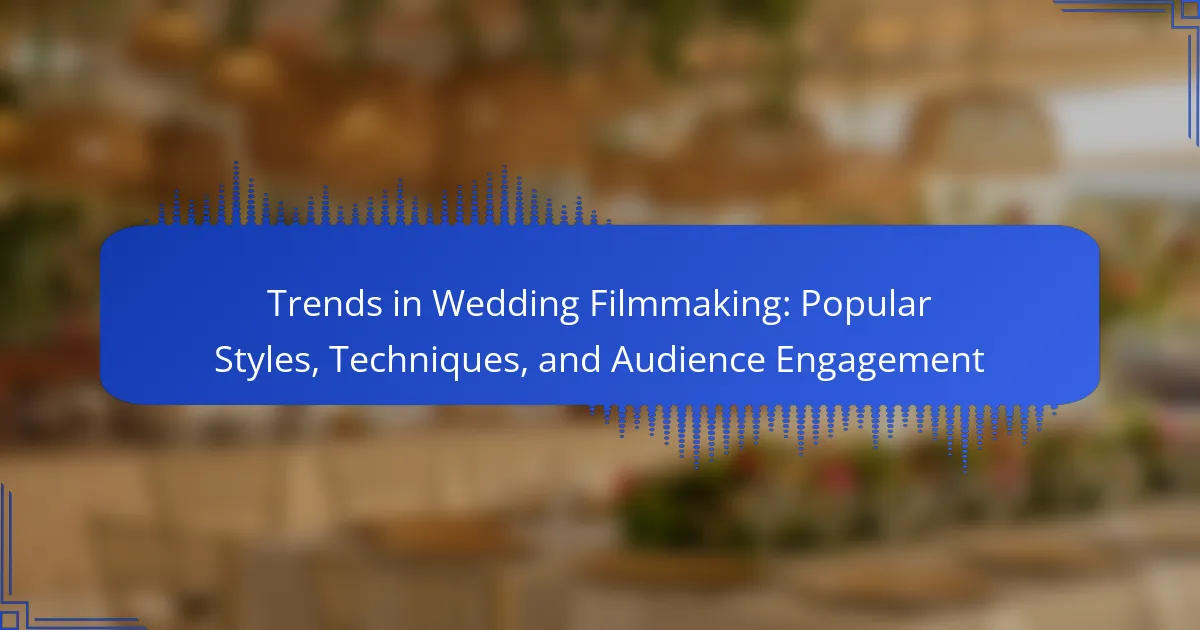Wedding filmmaking is the creative process of capturing and narrating a couple’s wedding day through video, blending technical skills with artistic vision to create a compelling visual narrative. The article explores key techniques such as storytelling, composition, and lighting, which enhance the emotional impact of wedding films. It also examines popular filmmaking styles, including cinematic, documentary, and storytelling approaches, each offering unique ways to convey the couple’s journey and emotions. Advancements in technology have further transformed wedding filmmaking, enabling higher quality visuals and innovative storytelling methods. The final product often serves as a cherished keepsake, preserving memories for years to come.
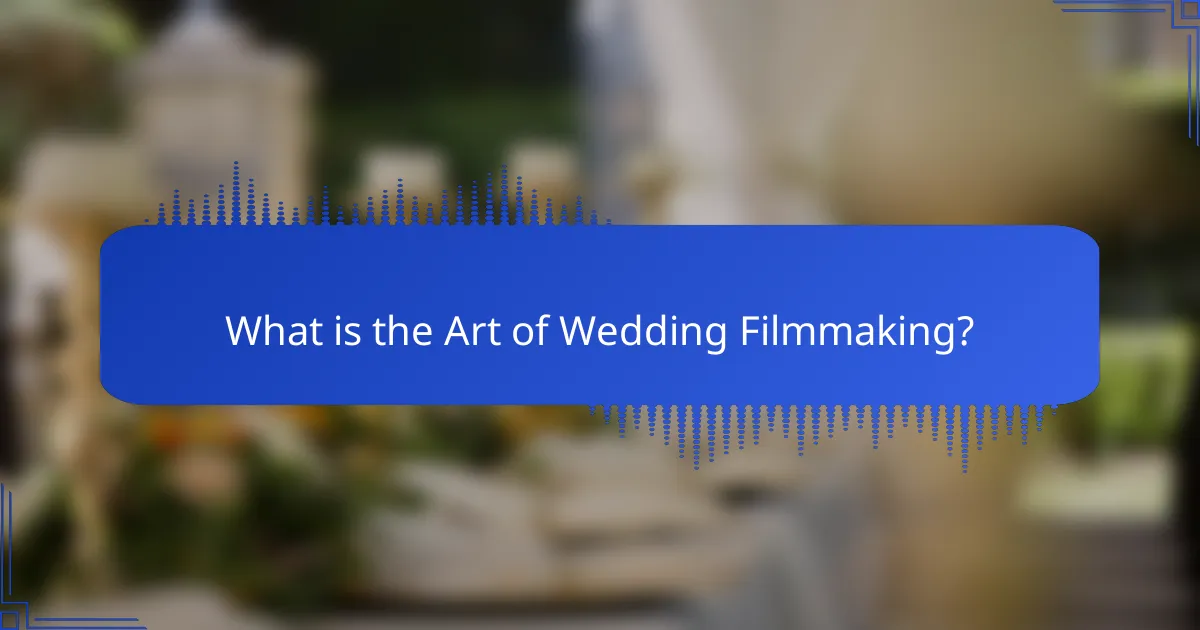
What is the Art of Wedding Filmmaking?
The art of wedding filmmaking is the creative process of capturing and narrating the story of a couple’s wedding day through video. It combines technical skills and artistic vision to produce a compelling visual narrative. Wedding filmmakers utilize various techniques, including cinematography, editing, and sound design, to enhance the emotional impact of the film. They often focus on key moments, such as vows, first dances, and candid interactions, to convey the couple’s unique story. The final product is typically a highlight reel or a full-length documentary-style film that preserves memories for years to come. Wedding filmmaking has evolved significantly with advancements in technology, allowing for higher quality visuals and innovative storytelling methods.
How has wedding filmmaking evolved over the years?
Wedding filmmaking has evolved significantly over the years. Initially, wedding videos were simple, single-camera recordings with minimal editing. These early films often featured static shots and long, unedited sequences. With advancements in technology, multi-camera setups became common. This allowed filmmakers to capture different angles and moments simultaneously.
The introduction of digital cameras in the 2000s improved video quality dramatically. Filmmakers began to adopt cinematic techniques, such as storytelling and artistic composition. Today, wedding films often resemble short movies, complete with professional editing and sound design.
The rise of drones has further transformed wedding filmmaking. Aerial shots provide a unique perspective that enhances the visual storytelling. Additionally, social media has influenced the style and distribution of wedding films. Many couples now expect highlight reels that can be shared online.
Overall, wedding filmmaking has shifted from basic documentation to a creative art form that captures the essence of the wedding day.
What historical influences shaped modern wedding filmmaking?
Modern wedding filmmaking is shaped by several historical influences. The invention of motion pictures in the late 19th century laid the groundwork for capturing live events. Early wedding films were simple, often featuring static shots and minimal editing. The introduction of sound in the 1920s allowed filmmakers to incorporate music and dialogue, enhancing emotional storytelling. The rise of television in the mid-20th century popularized documentary styles, influencing how weddings were filmed. Additionally, advancements in technology, such as handheld cameras and digital editing software, have made filmmaking more accessible. These developments have led to a shift from traditional wedding videos to cinematic storytelling, focusing on personal narratives and emotional connections.
How do cultural differences impact wedding filmmaking styles?
Cultural differences significantly impact wedding filmmaking styles. Each culture has unique traditions and rituals that influence how weddings are filmed. For instance, Indian weddings often feature vibrant colors and elaborate ceremonies, leading to dynamic cinematography. In contrast, Western weddings may focus more on intimate moments and storytelling. Additionally, cultural music choices shape the soundtrack and emotional tone of wedding films. Filmmakers adapt their techniques to align with cultural expectations, ensuring authenticity in representation. This adaptability enhances the overall emotional impact of the final product.
Why is wedding filmmaking important for couples?
Wedding filmmaking is important for couples because it captures their unique love story in a visual format. This medium allows couples to relive their special day through memories that can be cherished for a lifetime. Filmmaking preserves moments that still photography may miss, such as emotions and interactions. A well-crafted wedding film can evoke feelings of joy, nostalgia, and connection. Statistics show that 95% of couples who invest in wedding filmmaking say it was worth it for the memories created. Additionally, wedding films can be shared with family and friends who could not attend the event. This sharing fosters a sense of inclusion and connection among loved ones. Overall, wedding filmmaking serves as a timeless keepsake that reflects the couple’s journey and commitment.
What emotional significance does wedding filmmaking hold?
Wedding filmmaking captures the profound emotions of love, commitment, and joy. It serves as a visual narrative of a couple’s unique story. This medium preserves memories for a lifetime, allowing couples to relive their special day. The emotional significance is heightened through the use of music, editing, and storytelling techniques. These elements evoke nostalgia and connection for the couple and their families. Studies show that couples who invest in wedding films report higher satisfaction with their wedding experience. Wedding films often highlight key moments, such as vows and first dances, reinforcing emotional bonds. Ultimately, wedding filmmaking transforms fleeting moments into lasting memories.
How does wedding filmmaking preserve memories for future generations?
Wedding filmmaking preserves memories for future generations by capturing the significant moments of a couple’s special day. It documents emotions, interactions, and details that photographs alone may not convey. The visual and auditory elements of film create a narrative that can be revisited. This narrative allows future generations to experience their ancestors’ joy and love. Filmmaking also incorporates personal vows and speeches, adding depth to the memory. Studies show that video memories enhance recall and emotional connection. According to a study by the University of Southern California, video content is retained more effectively than static images. This retention makes wedding films valuable heirlooms for families.
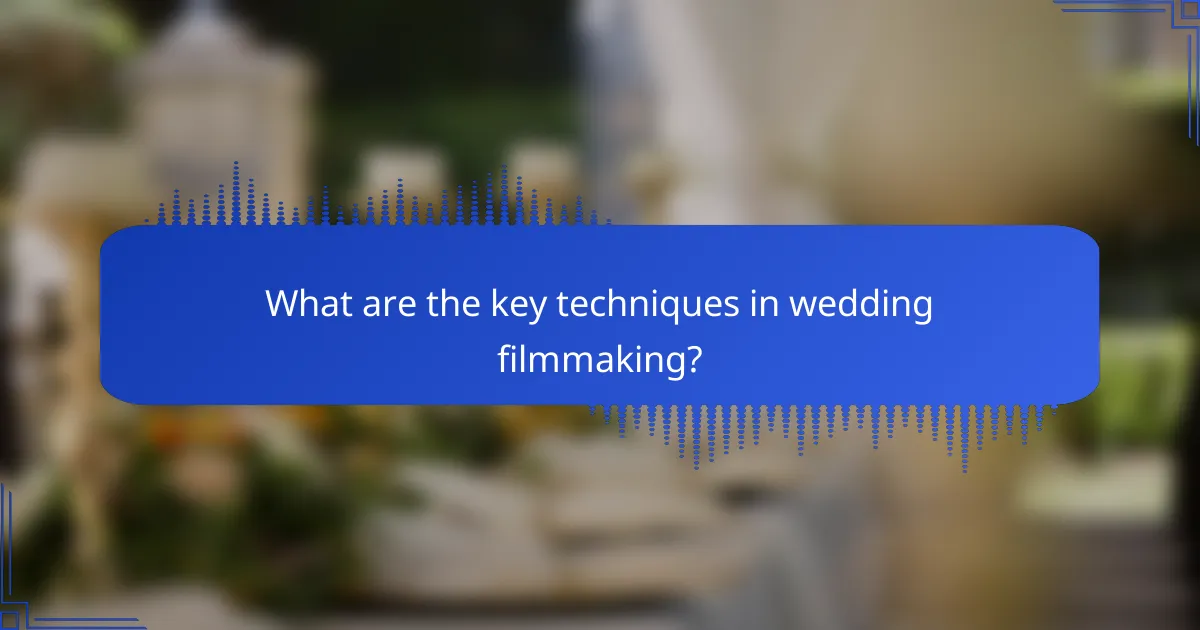
What are the key techniques in wedding filmmaking?
Key techniques in wedding filmmaking include storytelling, composition, and lighting. Storytelling involves capturing the couple’s journey and emotions throughout the day. Composition focuses on framing shots to enhance visual appeal. Lighting is crucial for setting the mood and capturing details. Additional techniques include using various camera angles and movements, such as tracking and panning. Editing techniques, like pacing and transitions, also play a significant role in creating a cohesive narrative. These techniques collectively contribute to an engaging and memorable wedding film.
How do filmmakers capture the essence of a wedding day?
Filmmakers capture the essence of a wedding day by focusing on key moments and emotions. They use a combination of storytelling techniques and visual aesthetics. Close-up shots highlight emotional expressions. Wide shots capture the overall atmosphere and setting. Filmmakers often use natural light to enhance the mood. They incorporate candid moments to evoke authenticity. Interviews with the couple add personal narratives. Music selection plays a crucial role in setting the tone. These methods collectively create a narrative that reflects the couple’s unique story.
What equipment is essential for effective wedding filmmaking?
Essential equipment for effective wedding filmmaking includes a high-quality camera, stabilizer, and audio recorder. A high-quality camera ensures sharp images and good low-light performance. Popular choices include DSLRs and mirrorless cameras. A stabilizer, such as a gimbal, helps achieve smooth footage during movement. Audio recorders capture clear sound, which is crucial for vows and speeches. Additional essential items include lenses for various shots, extra batteries for long events, and lighting equipment for indoor venues. This equipment collectively enhances the overall production quality of wedding films.
How do different shooting styles affect the final product?
Different shooting styles significantly influence the final product in wedding filmmaking. Each style conveys unique emotions and narratives. For example, a documentary style captures candid moments, creating a genuine and authentic feel. In contrast, a cinematic style often employs dramatic angles and lighting to enhance storytelling.
The choice of shooting style affects pacing and editing as well. Fast-paced styles may create excitement, while slower styles evoke intimacy. Additionally, the use of handheld versus tripod shots can alter the viewer’s connection to the scene. Handheld shots often feel more personal, while tripod shots provide stability and professionalism.
According to a study by the American Society of Cinematographers, shooting style directly impacts audience engagement and emotional response. Thus, selecting an appropriate shooting style is crucial for achieving the desired emotional impact in wedding films.
What editing techniques enhance wedding films?
Effective editing techniques enhance wedding films by improving narrative flow and emotional engagement. Techniques such as color grading create a cohesive visual style. Transitions, like crossfades and cuts, maintain rhythm and pacing. Incorporating slow motion highlights key moments, adding emotional weight. Sound design, including music and ambient sounds, enriches the viewing experience. Using montage sequences condenses time and captures the essence of the day. Incorporating interviews or voiceovers provides personal insights. These techniques collectively elevate the storytelling in wedding films.
How does color grading influence the emotional tone of a wedding film?
Color grading significantly influences the emotional tone of a wedding film. It alters the visual aesthetics, creating moods that resonate with viewers. Warm color tones evoke feelings of joy and intimacy. Conversely, cooler tones can instill a sense of calm or nostalgia. The choice of color palette affects audience perception and emotional engagement. For instance, vibrant colors can enhance celebratory moments. Subdued hues may highlight tenderness or melancholy. Studies show that color can impact emotional responses, with specific hues linked to distinct feelings. This demonstrates the power of color grading in shaping the narrative and emotional experience of wedding films.
What role does sound design play in wedding filmmaking?
Sound design plays a crucial role in wedding filmmaking by enhancing the emotional depth of the narrative. It helps to create an immersive experience for viewers. Effective sound design includes the use of ambient sounds, dialogue, and music. Ambient sounds capture the atmosphere of the wedding venue. Dialogue includes vows and speeches, which are central to the story. Music sets the tone and evokes specific emotions during key moments. Research shows that sound significantly impacts audience engagement and emotional response (Kätsyri et al., 2018). High-quality sound design can elevate the overall production value. It ensures that the essence of the day is accurately represented.
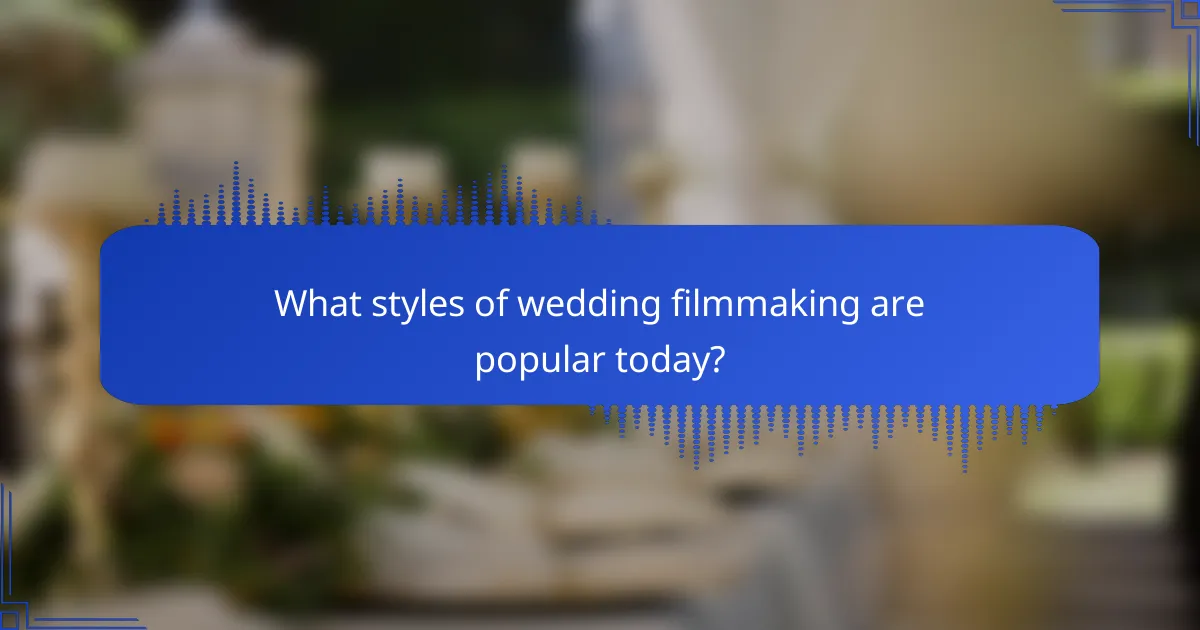
What styles of wedding filmmaking are popular today?
Cinematic, documentary, and storytelling styles are popular in wedding filmmaking today. Cinematic styles focus on dramatic visuals and artistic shots. This style often includes slow-motion sequences and carefully chosen music. Documentary styles capture events as they unfold, emphasizing authenticity. This approach often includes interviews and candid moments. Storytelling styles weave together narratives, highlighting the couple’s journey. Each style appeals to different preferences and enhances the emotional impact of the film. Popularity varies based on trends and individual tastes.
How do traditional and modern styles differ in wedding films?
Traditional wedding films focus on capturing the ceremony in a linear, documentary style. They often include full-length recordings of vows and speeches. The emphasis is on preserving the event as it happens, with minimal editing. This style typically features static camera angles and conventional framing.
In contrast, modern wedding films prioritize storytelling and artistic expression. They incorporate cinematic techniques, such as dynamic camera movements and creative editing. Modern films often include interviews and voiceovers, adding personal narratives. The use of music and stylized visuals enhances emotional engagement.
Overall, traditional films document events, while modern films aim to create an emotional experience through storytelling.
What are the characteristics of documentary-style wedding filmmaking?
Documentary-style wedding filmmaking captures real moments and emotions during the wedding day. This approach emphasizes authenticity and storytelling over posed shots. Filmmakers often use a candid style, allowing events to unfold naturally. They focus on key moments, such as vows and reactions, to create a narrative. The use of natural light is common, enhancing the genuine feel of the footage. Additionally, documentary filmmakers may incorporate interviews with the couple and guests. This style often results in a longer film that chronicles the day in detail. The final product aims to reflect the couple’s unique story and the atmosphere of their celebration.
How does cinematic wedding filmmaking stand out?
Cinematic wedding filmmaking stands out through its storytelling approach and high production quality. It employs techniques from narrative cinema, creating a more engaging experience. This style captures emotions and moments in a way that traditional wedding videography often does not. Cinematic films utilize advanced equipment, such as DSLRs and drones, for dynamic shots. They often include creative editing techniques, like slow motion and color grading, to enhance visual appeal. Additionally, cinematic wedding films typically feature a well-structured narrative arc, making the final product feel like a movie. This approach resonates emotionally with viewers, often resulting in a deeper connection to the couple’s story.
What emerging trends are shaping wedding filmmaking styles?
Emerging trends shaping wedding filmmaking styles include cinematic storytelling, drone footage, and documentary-style editing. Cinematic storytelling focuses on creating a narrative that captures the couple’s journey. This approach enhances emotional engagement and resonates with viewers. Drone footage offers unique aerial perspectives, providing stunning visuals that traditional methods cannot achieve. This trend has gained popularity due to advancements in drone technology. Documentary-style editing emphasizes authenticity by capturing real moments rather than staged scenes. This style reflects a more genuine representation of the day. Additionally, the use of social media snippets is increasing, allowing couples to share highlights quickly. These trends indicate a shift towards more personalized and visually striking wedding films.
How is technology influencing new wedding filmmaking techniques?
Technology is significantly influencing new wedding filmmaking techniques. Innovations such as drones provide aerial shots that enhance storytelling. High-definition cameras capture intricate details with clarity. Editing software allows for creative transitions and effects, making films more engaging. Smartphones enable filmmakers to capture candid moments spontaneously. Live streaming technology offers real-time sharing for remote guests. Virtual reality is emerging, providing immersive experiences of the wedding day. These advancements have transformed traditional filmmaking into a more dynamic art form.
What role do social media platforms play in wedding filmmaking trends?
Social media platforms significantly influence wedding filmmaking trends. They serve as key channels for sharing and discovering wedding films. Filmmakers showcase their work on platforms like Instagram and TikTok. This exposure helps them reach wider audiences and attract clients. Trends often emerge from viral content shared on these platforms. For instance, unique editing styles or storytelling techniques gain popularity quickly. Additionally, couples use social media to find inspiration for their weddings. They often share their own wedding films, creating a cycle of influence. Statistics show that 87% of brides use social media for wedding planning. This highlights the platforms’ role in shaping contemporary wedding filmmaking.
What practical tips can help aspiring wedding filmmakers?
Aspiring wedding filmmakers should focus on mastering their equipment. Understanding camera settings is crucial for capturing high-quality footage. Learning about lighting conditions can enhance the visual appeal of videos. Practicing storytelling techniques helps in creating engaging narratives. Building strong communication skills with clients ensures their vision is realized. Developing a structured shooting plan can streamline the filming process. Editing proficiency is essential for delivering polished final products. Networking with other professionals can lead to collaboration opportunities and referrals.
How can filmmakers improve their storytelling skills in wedding films?
Filmmakers can improve their storytelling skills in wedding films by focusing on emotional connections. Capturing genuine moments between couples enhances the narrative. Utilizing interviews with the couple adds depth and context. Planning a shot list ensures important moments are not missed. Incorporating music that resonates with the couple’s story can elevate emotional impact. Editing techniques, such as pacing and transitions, help maintain audience engagement. Studying successful wedding films provides insights into effective storytelling methods. Engaging with the couple’s family and friends can reveal unique stories to include.
What common mistakes should wedding filmmakers avoid?
Common mistakes wedding filmmakers should avoid include poor planning and lack of communication. Filmmakers often underestimate the importance of pre-wedding consultations. This can lead to misunderstandings about the couple’s expectations. Failing to scout locations beforehand can result in missed opportunities for stunning shots. Additionally, not having backup equipment can jeopardize the entire project. Filmmakers should also avoid over-editing footage, which can detract from the natural moments. Ignoring audio quality is another critical error, as poor sound can ruin an otherwise great video. Lastly, wedding filmmakers should avoid being intrusive during the ceremony, as this can disrupt the experience for the couple and guests.
The main entity of this article is wedding filmmaking, which encompasses the creative process of capturing and narrating a couple’s wedding day through video. The article provides an overview of the evolution of wedding filmmaking, highlighting historical influences, cultural impacts, and the emotional significance of preserving memories for future generations. Key techniques, styles, and equipment essential for effective filmmaking are discussed, along with emerging trends and practical tips for aspiring filmmakers. Additionally, the article examines how sound design and color grading enhance the emotional tone of wedding films, ultimately emphasizing the importance of storytelling in creating lasting memories.
